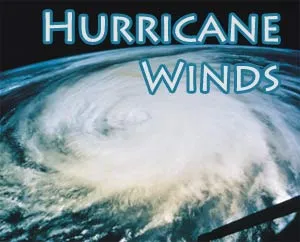 The Teacher's Corner
The Teacher's Corner
Puzzles and Activities
If you have watched any television, you have probably seen some of the news coverage of a hurricane. Unless you have been through one, it can be difficult to imagine what the winds are like. For this week's experiment, we will investigate hurricane winds a bit.
 You will need:
You will need:
First, lets take a look at wind speed and hurricanes. As the storm begins to build, it is called a tropical wave. If it begins to spin (due to the Coriolis Effect we talked about recently), then it becomes a tropical depression. To move up from tropical depression to tropical storm, the maximum winds have to be at least 40 miles per hour. At that point, the storm gets a name (like Charlie or Frances.)
The next step is at 74 miles per hour, where the tropical storm becomes a hurricane, but it does not stop there. From 74 to 95 miles per hour, it is a category 1 hurricane. Category 2 ranges from 96 to 110 miles per hour. Category 3 goes from 111 to 130, and category 4 from 131 to 155 miles per hour. If the maximum wind speed is more than 155 miles per hour, it is a category 5 hurricane.
Those are some pretty strong winds, but hard to imagine if you have not been through them. Some museums have hurricane simulations with giant fans, which are a lot of fun. If your local museum does not have one, you can still come close to experiencing hurricane force winds.
Get in the car and find a road where the speed limit is 40 miles per hour. With someone else driving (and the driver's permission), roll down a window. Now I am going to tell you to do something that will cause my mother to call and scold me. You are going to stick your hand out the window!
Be careful. Do not stick your head out. If a bug hits your hand at 40 miles per hour, it will hurt, but if it hit your face at that speed it could be serious. Do not stick anything else out, such as feet, paper cups or little brothers. Even accidental littering is against the law.
Feel the force of the wind against your hand. What you are feeling is pretty much the same as the minimum speed winds for a tropical storm. The difference is that in this case, the air is standing still and you are moving. Imagine trying to walk with that much wind blowing on you.
Many interstate highways have 70 mile per hour speed limits, so with the driver's permission, you could experience near hurricane speed winds. After feeling that, it is much easier to see how the wind can peel the roof off of a house or topple a tree.
Have a wonder filled week.
 Check out more Science Experiments
Check out more Science Experiments
All lessons are brought to you by The Teacher's Corner and Robert Krampf's Science Education Company.
Robert Krampf's Science Shows thehappyscientist.com